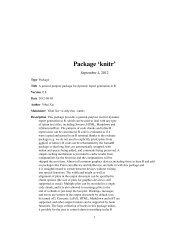Package 'openair'
Package 'openair'
Package 'openair'
Create successful ePaper yourself
Turn your PDF publications into a flip-book with our unique Google optimized e-Paper software.
130 timeVariationtypegroupdifferenceBcicolskeykey.columnsstart.dayauto.textalphatype determines how the data are split i.e. conditioned, and then plotted. Thedefault is will produce a single plot using the entire data. Type can be one ofthe built-in types as detailed in cutData e.g. “season”, “year”, “weekday” andso on. For example, type = "season" will produce four plots — one for eachseason.It is also possible to choose type as another variable in the data frame. If thatvariable is numeric, then the data will be split into four quantiles (if possible)and labelled accordingly. If type is an existing character or factor variable, thenthose categories/levels will be used directly. This offers great flexibility for understandingthe variation of different variables and how they depend on oneanother.Only one type is allowed intimeVariation.This sets the grouping variable to be used. For example, if a data frame had acolumn site setting group = "site" will plot all sites together in each panel.See examples below.If two pollutants are chosen then setting difference = TRUE will also plot thedifference in means between the two variables as pollutant[2] - pollutant[1].Bootstrap 95% confidence intervals of the difference in means are also calculated.A horizontal dashed line is shown at y = 0.Number of bootstrap replicates to use. Can be useful to reduce this value whenthere are a large number of observations available to increase the speed of thecalculations without affecting the 95% confidence interval calculations by much.Should confidence intervals be shown? The default is TRUE. Setting this to FALSEcan be useful if multiple pollutants are chosen where over-lapping confidenceintervals can over complicate plots.Colours to be used for plotting. Options include “default”, “increment”, “heat”,“jet” and RColorBrewer colours — see the openair openColours functionfor more details. For user defined the user can supply a list of colour namesrecognised by R (type colours() to see the full list). An example would becols = c("yellow", "green", "blue")By default timeVariation produces four plots on one page. While it is usefulto see these plots together, it is sometimes necessary just to use one for a report.If key is TRUE, a key is added to all plots allowing the extraction of a single plotwith key. See below for an example.Number of columns to be used in the key. With many pollutants a single columncan make to key too wide. The user can thus choose to use several columns bysetting columns to be less than the number of pollutants.What day of the week should the plots start on? The user can change the startday by supplying an integer between 0 and 6. Sunday = 0, Monday = 1, . . . Forexample to start the weekday plots on a Saturday, choose start.day = 6.Either TRUE (default) or FALSE. If TRUE titles and axis labels will automaticallytry and format pollutant names and units properly e.g. by subscripting the ‘2’ inNO2.The alpha transparency used for plotting confidence intervals. 0 is fully transparentand 1 is opaque. The default is 0.4
















